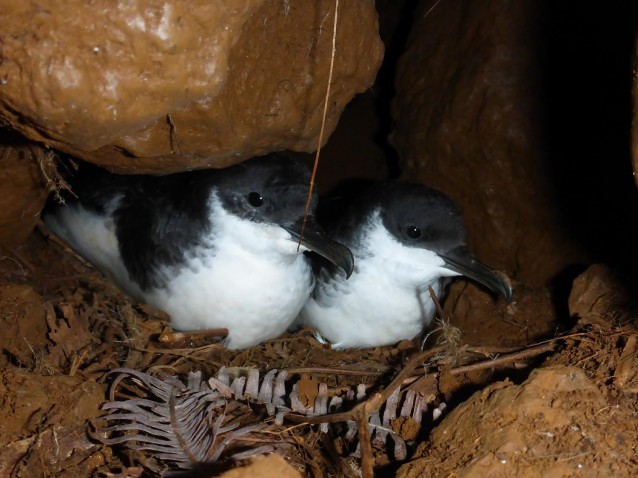
Hawaiian Name: ʻAʻo
Scientific Name: Puffinus newelli
Conservation Status:
Federal Status: Threatened
State Status: Threatened
IUCN Red List: Endangered
Population Size
Once numerous, the ʻAʻo was thought to be extinct by the early 1900s. Then, in 1947 a bird was sighted off of Kauaʻi and in 1967 a colony was discovered on the island. The most recent population estimate of this endangered seabird is 19,000 breeding pairs, but this was based on at-sea surveys from 1980-1994. Between 1993 and 2013, radar studies conducted by KESRP and Cooper & Day, revealed that the species suffered a catastrophic population decline of 94% (Raine et al 2017), meaning that the breeding population of Newell’s Shearwater is now a shadow of what it was in the 1980s and early 1990s.
Distribution
Kauaʻi holds 90% of the remaining population of the Newell’s Shearwater, making the island the last Refuge for this enigmatic species and critical to its survival. As this species is endemic to the Hawaiian Islands, this means that Kauaʻi also holds the largest breeding population of this bird on the planet. Due to the various threats that face this species, the main populations on Kauai are now concentrated in the north-west of Kauai in areas such as Upper Limahuli Preserve and Hono o Na Pali NAR. There are smaller populations on Hawaiʻi Island and Maui, as well as a possible breeding population on Lehua. Historically the species also bred on Molokaʻi and Oʻahu.

Breeding
The Newell’s Shearwater nests in burrows beneath ferns and tree roots in dense forest and on steep slopes and cliffs. Newell’s Shearwaters only fly to and from their burrows at night. The Newell’s has a very distinctive call that sounds like a braying donkey, which can be heard in many places on Kauaʻi just after sunset. They are thought to start visiting their breeding colonies at 2-3 years of age, but likely do not breed until 5 or 6 years of age.
Pairs mostly mate for life, and only lay one egg each breeding season. Nestled beneath thick vegetation, these burrows are extremely difficult to find. The Newell’s Shearwater breeding season runs from April to early November, and during the 5-7 months it takes to raise a chick, the parents take turns sitting on the egg and going out to sea to feed. Once the chick is hatched, both parents will go to sea during the day, with one returning each night to feed the chick. During the non-breeding season, from December to March, these birds remain at sea.


Diet and Foraging
As with most seabirds, the Newell’s Shearwater feeds only at sea, where they eat schooling fish and squid. They have a keen sense of smell and forage both during the day and at night. Like many shearwaters, they are excellent divers and can pursue their prey to depths of over 150 feet!
Identification
The Newell’s Shearwater could be confused with the larger and much more common Wedge-tailed Shearwater, but Newell’s Shearwater can be readily separated by its dark black back, contrastingly white underside and underwing, and a very quick, almost frantic flapping style with the wings held straight. Light morph Wedge-tailed Shearwater has a dark brown back with blurry brown side of the head, and much smoother and slower flaps with wings held bent back at the middle. The two species are often found together at sea, but the Wedge-tailed Shearwater is always the more common species.




